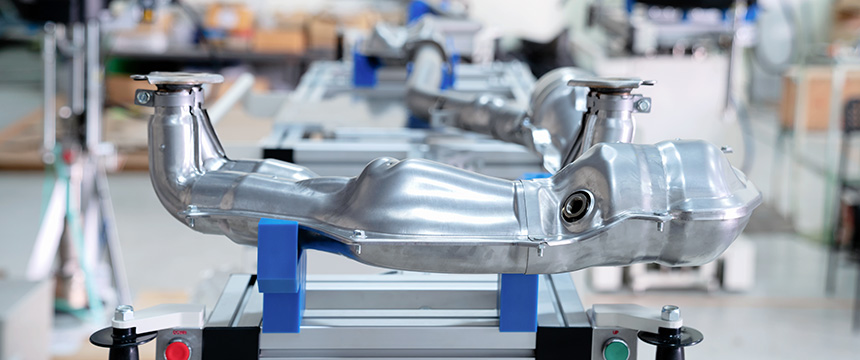Key Takeaways from AmericaMakes: 2022 RAPID + TCT Additive Manufacturing (3D Printing) Conference
Industry Insights, Protecting Your Property/Information and Building a Foundation for Compliance with Labor and Employment Laws

On May 17-19, 2022, the AmericaMakes: RAPID + TCT Additive Manufacturing Conference was held in Detroit, Michigan. The event involved a mixture of thought leadership panels, large group presentations, small group presentations, and an exhibit showroom. Throughout the week, there were two major takeaways highlighted at the conference: (1) the future is 3D printing and that future is “glocal” and (2) everyone contributes to the larger ecosystem. Below are some legal industry takeaways that will highlight what businesses in this industry can and should be doing to protect their products and services.
The Future is 3D Printing and That Future is “Glocal”
Although some businesses or manufacturers are resistant to change and implementing 3D printing in their processes or product build, additive manufacturing (traditionally known as 3D printing) is the manufacturing process rapidly becoming the “go-to” manufacturing process for many different industries. Not only does 3D printing provide time efficiency for prototyping and limited production runs (e.g., fewer than 10,000 units depending on the item being produced), but in some instances may be more environmentally friendly than previous manufacturing processes. The manufacturing industry is now operating on a “glocal” scale as the marketplace relies on international collaboration. Specifically, within the automotive industry (and in the midst of the supply chain shortages), 3D printing’s “glocal” scale provides the ability for automobile manufacturers to obtain parts from anywhere in the world (or within their own facility in the instance of investing in a 3D printer on-site). The ability to produce replacement parts is also much more manageable for logistics teams and less expensive from a storage perspective.
Everyone Contributes to the Larger Ecosystem
Multiple speakers pointed out the need for collaboration throughout the industry to bring additive manufacturing to a larger scale. The “ecosystem” of additive manufacturing involves a team of businesses bringing 3D printing to the forefront of manufacturing by providing multiple solutions to current manufacturing dilemmas and working together to provide businesses with practical and efficient solutions. Historically, 3D printing had limited materials from which to use in creating parts and products; however, the industry has evolved over the past number of years and is now heavily focused on new materials, equipment to print using those materials, and new processes that improve quality of final parts and products.
Legal Takeaways
1. Protect Your Intellectual Property
The additive manufacture ecosystem includes manufacturers of 3D printers and supporting systems (e.g., print material supply systems to the 3D printers), contract manufacturers, and, of course, product manufacturers who use additive manufacturing. Traditional IP categories include patents, trademarks, copyrights, trade dress, and trade secrets. Often know-how and negative know-how become valuable IP assets, especially for young manufacturing processes. Given the explosive amount of new materials and equipment being developed to support the new materials, the additive manufacturing industry will find all areas of IP to be effective. Patents include both utility patents (protect structure and function) and design patents (protect ornamental appearance).
New materials range from a wide variety of metals, plastics, and even biological substances. With these new materials, new or upgraded machines have to be created. The new or upgraded machines often include new structure features and often upgraded software to accommodate the new materials. Moreover, testing equipment is often developed to perform QA functions of the new materials. The new materials are often created to produce products that cannot use existing materials for various reasons (e.g., biological products).
Patents are often the primary focus of protection of clients. Thousands of patents are granted annually for additive manufacturing. Patents will likely serve as a necessary IP asset to show that a company is innovative, but also as both offensive and defensive weapons depending on the nature of the business and aggressiveness of the company. With such a crowded market, strategic patenting can be invaluable to produce quality patents.
Copyrights may be beneficial given the extensive use of software programmers in the additive manufacturing market. Registered copyrights can be a valuable tool to reduce motivation for existing programmers to misappropriate software when the programmers join a competitor. In filing for copyright registration with the U.S. Copyright Office, it is suggested to use a trade secret strategy in the copyright filing so that both copyright and trade secret IP assets are available in the event that a programmer joins or becomes a competitor to the company. Of course, with any trade secret, trade secrets embedded in software must be protected as a trade secret (e.g., limited access, maintained within the company, track who actually accesses the trade secret code, etc.)
Trademarks and trade dress can also be valuable assets. Trademarks are typically in the form of words and symbols that are source identifiers to a source of goods and services. Trade dress filings with the U.S. trademark office can also be used to protect shapes of products and packaging. Such an IP asset is much less common, but can be very valuable in certain circumstances when the shape of a product operates as a source identifier (e.g., certain bottle shape).
Know-how and negative know-how may not rise to the level of trade secret, but such IP assets may provide a natural barrier to competitors and may serve as valuable IP assets for exit sales of a company. Of course, know-how and negative know-how serve as excellent competitive advantages.
IP assets for the additive manufacturing should be protected holistically, in that a careful analysis of the product and service being created and performed by the company should be made so that an IP attorney can evaluate and prescribe appropriate IP assets to protect the company. Depending on the nature of the company (e.g., machine manufacturer, service bureau, or end-product manufacturer), different IP assets will be more valuable in protecting the company.
2. Protect Your Trade Secrets and Confidential Information
A business should also appropriately safeguard its trade secrets and confidential information. As a first step, businesses should consider executing agreements with employees that include restrictive covenants, such as non-competition, non-solicitation, and/or non-disclosure provisions (as appropriate), to ensure that confidential information, trade secrets, and other business assets are protected. These agreements should be used in conjunction with the protections listed above, as the copyright filing process alongside restrictive covenants can serve as a major barrier for existing employees to become would-be competitors. Businesses should consult with labor and employment counsel to ensure these provisions are enforceable (as state law heavily dictates the enforceability of restrictive covenant provisions) and to adequately protect the appropriate interests.
Additionally, employment agreements (especially those with executives) should contain proper invention assignment clauses. In the automotive industry, when additive manufacturing may be performed internally, these steps are especially important. However, even when additive manufacturing is performed externally, there are still important processes worthy of protection. Consultants should also be carefully contracted to capture IP developments and limit those developments from moving to competitors in future engagements by the consultants.
3. Build the Foundation for Compliance with Labor and Employment Laws
Start-ups in the additive manufacturing industry should consult with counsel to ensure compliance with labor and employment laws. There are key steps businesses must take in the early stages of employing (or contracting) with individuals to ensure compliance with federal, state, and local employment laws. Specifically, a business should consider proper completion of Form I-9s, drafting written policies (such as an employee handbook), analyzing the FLSA status (exempt or non-exempt) of employees, time tracking, vacation/sick time, and bonus/compensation structure to name a few.
As we previously published, in the wake of the new wave of unionization and because the manufacturing industry is already heavily unionized, businesses should seek counsel to address potential unionization of the workforce and best practices.

